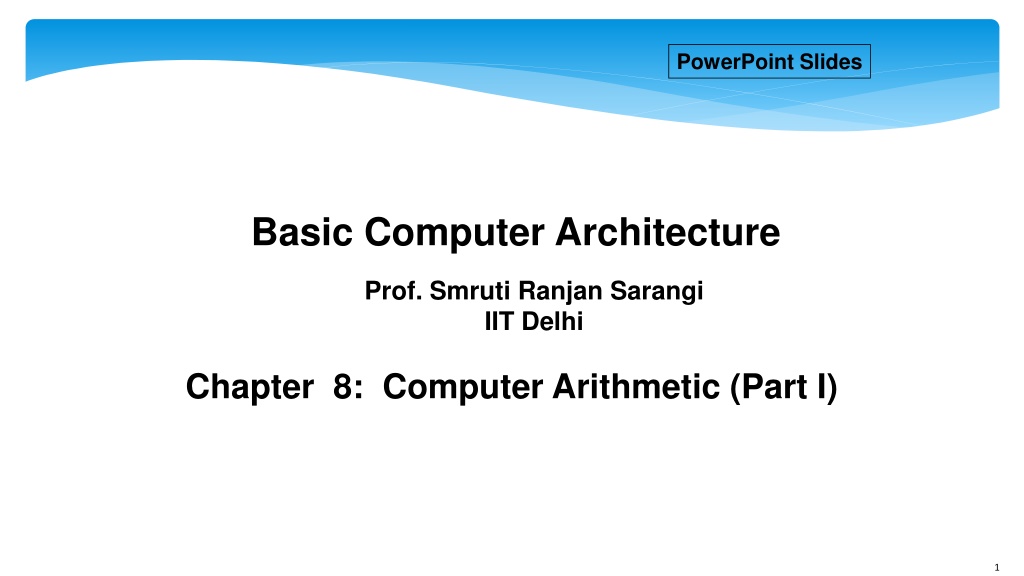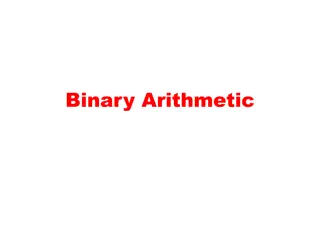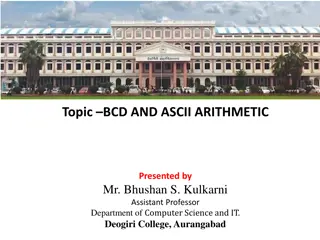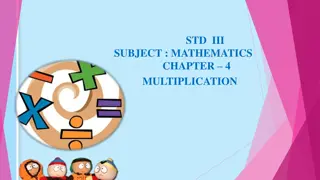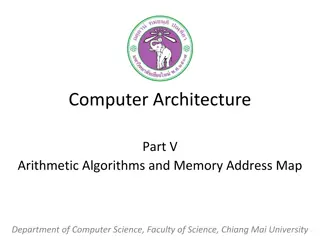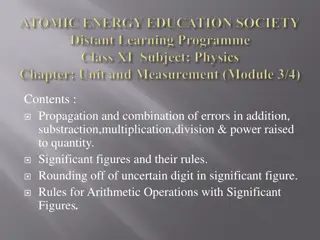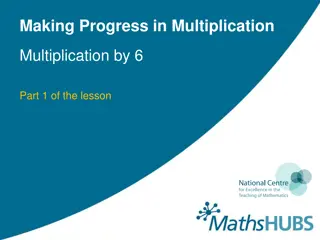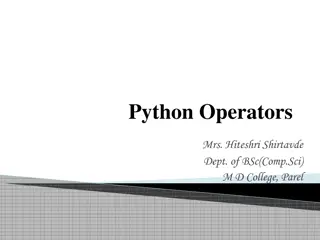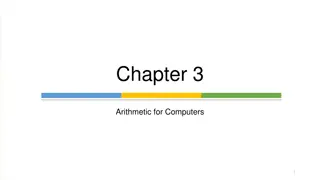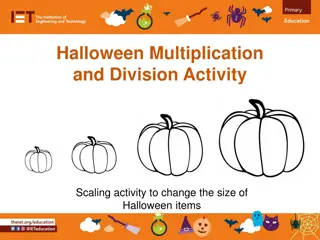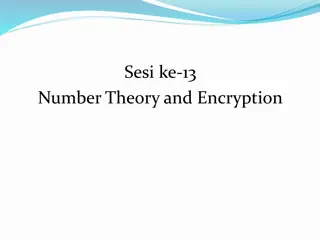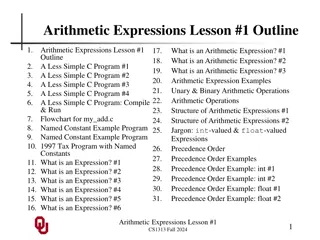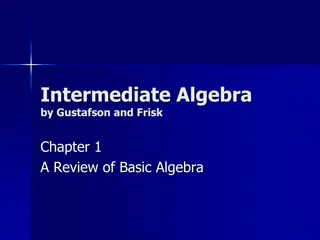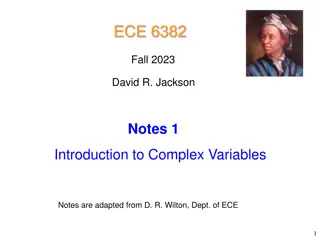Understanding Computer Arithmetic Basics: Addition, Multiplication, Division, and More
Delve into the fundamentals of computer arithmetic with concepts such as adding 1-bit numbers, half adders, full adders, equations, circuits, and the addition of n-bit numbers. Explore the intricacies of binary arithmetic operations and learn how computers perform calculations effectively.
Download Presentation

Please find below an Image/Link to download the presentation.
The content on the website is provided AS IS for your information and personal use only. It may not be sold, licensed, or shared on other websites without obtaining consent from the author. Download presentation by click this link. If you encounter any issues during the download, it is possible that the publisher has removed the file from their server.
E N D
Presentation Transcript
PowerPoint Slides Basic Computer Architecture Prof. Smruti Ranjan Sarangi IIT Delhi Chapter 8: Computer Arithmetic (Part I) 1
2nd version www.basiccomparch.com Download the pdf of the book videos Slides, software, solution manual Print version (Publisher: WhiteFalcon, 2021) Available on e-commerce sites. The pdf version of the book and all the learning resources can be freely downloaded from the website: www.basiccomparch.com
Outline Addition Multiplication Division Floating Point Addition Floating Point Multiplication Floating Point Division 3
Adding Two 1 bit Numbers Let us add two 1 bit numbers a and b 0 + 0 = 00 1 + 0 = 01 0 + 1 = 01 1 + 1 = 10 The lsb of the result is known, as the sum, and the msb is known as the carry 4
Sum and Carry a a a b carry sum a 0 0 1 1 b 0 1 0 1 s 0 1 1 0 c 0 0 0 1 S = a b = ?.b + a. ? c = a.b Truth Table 5
Half Adder Adds two 1 bit numbers to produce a 2 bit result Half adder b a S C a b S a b C 6
Full Adder Add three 1 bit numbers to produce a 2 bit output ? + ? + ???= 2 ????+ ? a b cin 0 s cout 0 0 0 0 0 1 0 1 0 1 0 0 1 0 1 1 0 0 1 0 0 1 1 0 0 1 1 0 1 1 0 1 0 1 1 1 1 1 1 7
Equations for the Full Adder s = ? ? ??? = ?. ? + ?.b ??? = ?. ? + ?.b .???+ ?. ? + ?.b.??? = ?. ?.???+ ?.b.???+ (?. ?). ?.? .??? = ?. ?.???+ ?.b.???+ ? + ? . ? + ? .??? = ?. ?.???+ ?.b.???+ ?. ?.???+ ?.?.??? ???? = ?.? + ?.???+ ?.??? 8
Circuit for the Full Adder a b Full adder S cout cin a b a a cout cin b cin cin b s 9
Addition of two n bit numbers 1 1 1 1 1 0 1 1 0 1 0 1 1 0 0 0 0 We start from the lsb Add the corresponding pair of bits and the carry in Produce a sum bit and a carry out 10
Observations We keep adding pairs of bits, and proceed from the lsb to the msb If a carry is generated, we add it to the next pair of bits At the last step, if a carry is generated, then it becomes the msb of the result The carry effectively ripples through the bits 11
Ripple Carry Adder Half adder Full adder c carry A1B1 A2B2c AnBnc A3B3c Result 12
Operation of the Ripple Carry Adder Problem : Add A + B Number the bits : A1 to An and B1 to Bn lsb A1 and B1 msb An and Bn Use a half adder to add A1 and B1 Send the carry(c) to a full adder that adds : A2 + B2 + c Proceed in a similar manner till the msb 13
How long does the Ripple Carry Adder take ? Time : Time of half adder : th Time of full adder : tf Total Time : th + (n-1)tf 14
Asymptotic Time Complexity Most of the time, we are primarily interested in the order of the function For example : we are only interested in the n2 term in (2n2 + 3n + 4) We do not care about the constants, and terms with smaller exponents 3n and 4 We can thus say that : 2n2 + 3n + 4 is order of (n2) 15
The O notation Formally : We say that: f(n) = O(g(n)) if, ? ? ? ? ? , for all ? > ?0. Here c is a positive constant. In simple terms: Beyond a certain n , g(n) is greater-than-equal to a certain constant times f(n) For example, beyond 15, (n2+ 10n + 16) 2n2 16
Example of the big O Notation f(n) = 3n2 + 2n + 3. Find its asymptotic time complexity. Answer: f(n) = 3n2 + 2n + 3 3n2+ 2n2+ 3n2(n > 1) 8(n2) Hence, f(n) = O(n2). 800 f(n) 8n^2 700 600 500 400 time 300 200 100 0 0 2 4 6 8 10 n 8n2is a strict upper bound on f(n) as shown in the figure. 17
Big O Notation - II Example: f(n) = 0.00001n100 + 10000n99 + 234344. Find its asymptotic time complexity. Answer: f(n) = O(n100) We shall use the asymptotic time complexity metric (big O notation) to characterize the time taken by different adders 18
Ripple Carry Adders and Beyond Time complexity of a ripple carry adder : O(n) Can we do better than O(n) ? Yes 19
Carry Select Adder O(n) time Group bits into blocks of size (k) If we are adding two 32 bit numbers A and B, and k = 4, then the blocks are : Carry propagating across blocks A5 A1 A7 A32 A31A30A29 A6 A3 A8 A2 A4 B5 B1 B7 B32 B31B30B29 B6 B3 B8 B2 B4 Produce the result of each block with a small ripple carry adder 20
Carry Select Adder - II In this case, the carry propagates across blocks Time complexity is O(n) Idea : Add the numbers in each block in parallel Stage I : For each block, produce two results Assuming an input carry of 0 Assuming an input carry of 1 21
Carry Select Adder Stage II For each block we have two results available Result (k sum bits), and 1 carry out bit Stage II Start at the least significant block The input carry is 0 Choose the appropriate result from stage I We now know the input carry for the second block Choose the appropriate result Result contains the input carry for the third block 22
Carry Select Adder Stage II Given the result of the second block Compute the carry in for the third block Choose the appropriate result Proceed till the last block At the last block (most significant positions) Choose the correct result The carry out value, is equal to the carry out of the entire computation. 23
How much time did we take ? Our block size is k Stage I takes k units of time There are n/k blocks Stage II takes (n/k) units of time Total time : (k + n/k) ? (? + ?/?) ?? 1 = 0 ? ?2= 0 ? ? = 24
Time Complexity of the Carry Select Adder T = O( n + n) = O( n) Thus, we have a n time adder Can we do better ? Yes 25
Carry Lookahead Adder (O(log n)) The main problem in addition is the carry If we have a mechanism to compute the carry quickly, we are done Let us thus focus on computing the carry without actually performing an addition 26
Generate and Propagate Functions Let us consider two corresponding bits of A and B Ai and Bi Generate function : A new carry is generated (Cout = 1) Propagate function : Cout = Cin Generate and Propagate Functions are : ??= ??.?? ??= ?? ?? 27
Using the G and P Functions If we have the generate and propagate values for a bit pair, we can determine the carry out Cout = gi + pi.Cin 28
Example Example: Let Ai = 0, Bi = 1. Let the input carry be Cin. Compute gi, pi, and Cout. Answer: ??= ??.??= 0.1 = 0 ??= ?? ??= 0 1 = 1 ????= ??+ ??.???= ??? 29
G and P for Multi-bit Systems Cout Cin gi generate value for ith bit pair pi propagate value for ith bit pair output carry for ith i input carry for ith bit pair i bit pair 30
G and P for Multibit Systems - II 1 1 ???? = ?1+ ?1.??? 2 1 ???? = ?2+ ?2. ?1+ ?1.??? = ?2+ ?2.?1 + ?2.?1.??? = ?2+ ?2.???? 1 1 3 2 ???? = ?3+ ?3. = ?3+ ?3.?2+ ?3.?2.?1 + ?3.?2.?1.??? = ?3+ ?3.???? 1 ?2+ ?2.?1 + ?2.?1.??? 1 31
G and P for multibit Systems - III 3 4 ???? = ?4+ ?4. = ?4+ ?4.?3+ ?4.?3.?2+ ?4.?3.?2.?1 + ?4.?3.?2.?1.??? = ?4+ ?4.???? 1 ?3+ ?3.?2+ ?3.?2.?1 + ?3.?2.?1.??? 1 32
Patterns 1 bit 1 1 ???? = ?1 ?1 + ?1 .??? ?1 2 bit 1 2 ???? = ?2+ ?2.?1 + ?2.?1 .??? ?2 ?2 3 bit 1 3 ???? = ?3+ ?3.?2+ ?3.?2.?1 + ?3.?2.?1 .??? ?3 ?3 4 bit 1 4 ???? = ?4+ ?4.?3+ ?4.?3.?2 + ?4.?3.?2.?1 + ?4.?3.?2.?1 .??? ?4 ?4 1 ? ???? = ??+ ??.??? n bit 33
Computing G and P Quickly Let us divide a block of n bits into two parts C sub n C in C out m+1,n 1,m Let the carry out and carry in be : Cout and Cin We want to find the relationship between G1,n, P1,n and (Gm+1,n, G1,m, Pm+1,n, P1,m) 34
Computing G and P Quickly - II ????= ??+1,?+ ??+1,?.???? = ??+1,? + ??+1,?. ?1,?+ ?1,?.??? = ??+1,?+ ??+1,?.?1,? ?1,? + ??+1,?.?1,? ?1,? .??? ????= ?1,?+ ?1,?.??? G1,n = Gm+1,n + Pm+1,n.G1,m P1,n = Pm+1,n.P1,m 35
Insight into Computing G and P quickly Insight : We can compute G and P for a large block By first computing G and P for smaller sub-blocks And, then combining the solutions to find the value of G and P for the larger block Fast algorithm to compute G and P Use divide-and-conquer Compute G and P functions in O (log (n)) time 36
Carry Lookahead Adder Stage I Compute G and P functions for all the blocks Combine the solutions to find G and P functions for sets of 2 blocks Combine the solutions fo find G and P functions for sets of 4 blocks . . Find the G and P functions for a block of size : 32 bits 37
Carry Lookahead Adder Stage I Block 16 Block 1 Computation level 0 4 3 31 30 29 2 1 32 level 1 G,P 30-29 G,P 4-3 G,P 2-1 G,P 32-31 G,P 32-29 G,P 4-1 level 2 G,P 32-25 G,P 8-1 G,P 24-17 G,P 16-9 level 3 G,P 32-17 G,P 16-1 level 4 G,P 32-1 level 5 38
CLA Adder Stage I Compute G, P for increasing sizes of blocks in a tree like fashion Time taken : Total : log(n) levels Time per level : O(1) Total Time : O(log(n)) 39
CLA Adder Stage II Result Bits 2-bit RC Adder 30 2-bit RC Adder 2-bit RC Adder 2-bit RC Adder 2-bit RC Adder level 0 32 31 29 18 17 4 3 2 1 Computation G,P 18-17 level 1 G,P 30-29 G,P 4-3 G,P 2-1 G,P 32-31 1 cin 1 G,P 32-29 G,P 28-25 G,P 20-17 G,P 4-1 level 2 cin G,P 32-25 G,P 8-1 1 level 3 G,P 24-17 G,P 16-9 cin G,P block 1 level 4 G,P 32-17 G,P 16-1 cin cout cin G,P r1- r2 32 1 cout level 5 G,P 32-1 cin 40
Connection of the G,P Blocks Each G,P block represents a range of bits (r2, r1) (r2 > r1) The (r2, r1) G,P block is connected to all the blocks of the form (r3, r2+1) The carry out of one block is an input to all the blocks that it is connected with Each block is connected to another block at the same level, and to blocks at lower levels 41
Operation of CLA Stage II We start at the leftmost blocks in each level We feed an input carry value of Cin Each such block computes the output carry, and sends it to the all the blocks that it is connected to Each connected block 1 Computes the output carry Sends it to all the blocks that it is connected to The carry propagates to all the 2 bit RC adders 42
CLA Adder Stage II Result Bits 2-bit RC Adder 30 2-bit RC Adder 2-bit RC Adder 2-bit RC Adder 2-bit RC Adder level 0 32 31 29 18 17 4 3 21 Computation G,P 18-17 level 1 G,P 30-29 G,P 4-3 G,P 2-1 G,P 32-31 1 cin 1 G,P 32-29 G,P 28-25 G,P 20-17 G,P 4-1 level 2 cin G,P 32-25 G,P 8-1 1 level 3 G,P 24-17 G,P 16-9 cin G,P block 1 level 4 G,P 32-17 G,P 16-1 cin cout cin G,P r1- r2 32 1 cout level 5 G,P 32-1 cin 43
Time Complexity In a similar manner, the carry propagates to all the RC adders at the zeroth level Each of them compute the correct result Time taken by Stage II : Time taken for a carry to propagate from the (16,1) node to the RC adders O(log(n)) Total time : O(log(n) + log(n)) = O(log(n)) 44
Time complexities of different adders: Ripple Carry Adder: ?(?) Carry Select Adder: ? Carry Lookahead Adder: ?(log ? ) ? 45
Outline Addition Multiplication Division Floating Point Addition Floating Point Multiplication Floating Point Division 46
Multiplicands 1 1 0 1 1 3 1 0 0 1 1 1 0 1 0 0 0 0 0 0 0 0 1 1 0 1 1 1 1 0 1 0 1 (b) 9 1 1 7 (a) Partial sums 13 Multiplicand 9 Multiplier 117 Product 47
Basic Multiplication Consider the lsb of the multiplier If it is 1, write the value of the multiplicand If it is 0, write 0 For the next bit of the multiplier If it is 1, write the value of the multiplicand shifted by 1 position to the left If it is 0, write 0 Keep going . 48
Definitions Partial sum: It is equal to the value of the multiplicand left shifted by a certain number of bits, or it is equal to 0. Partial product: It is the sum of a set of partial sums. If the multiplier has m bits, and the multiplicand has n bits The product requires (m+n) bits 49
Multiplying 32 bit numbers Let us design an iterative multiplier that multiplies two 32 bit signed values to produce a 64 bit result What did we prove before Multiplying two signed 32 bit numbers, and saving the result as a 32 bit number is the same as Multiplying two unsigned 32 bit numbers (assuming no overflows) We did not prove any result regarding saving the result as a 64 bit number 50
